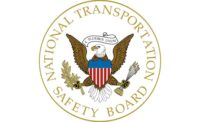The National Transportation Safety Board (NTSB) has found that the probable cause for the crash of a de Havilland DHC-3 in Soldotna, Alaska, on July 7, 2013, was the operator’s failure to determine the actual cargo weight, leading to the loading and operation of the airplane outside of its weight and center of gravity limits.
Contributing to the accident was the Federal Aviation Administration’s failure to require weight and balance documentation for this type of air taxi flight.
The flight was headed from Soldotna to a lodge 90 miles away when the airplane stalled and crashed on takeoff. The airplane was destroyed by impact forces and post-crash fire and the pilot and nine passengers were fatally injured.
A video of the airplane’s taxi, takeoff roll and takeoff was recovered from a passenger’s personal electronic device. An NTSB video study indicated that shortly after takeoff, the airplane’s angle of attack continually increased as the airplane’s airspeed decreased from about 68 mph to about 44 mph over a period of about 8.5 seconds. About 11 seconds after takeoff, airspeed and angle of attack reached values consistent with an aerodynamic stall. The airplane rolled right-wing-down and impacted the ground several seconds later.
The weight of the cargo recovered from the crash site, and determination of the weight of cargo destroyed in the impact and post-crash fire, showed the cargo weight was about 418 pounds higher than the cargo weight stated on the load manifest, resulting in a center of gravity aft of the limits for the airplane.
Read the full report here: www.ntsb.gov/_layouts/ntsb.aviation/brief.aspx


